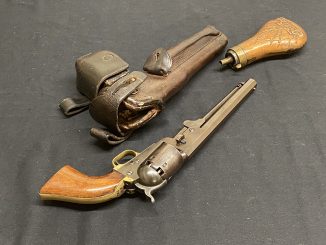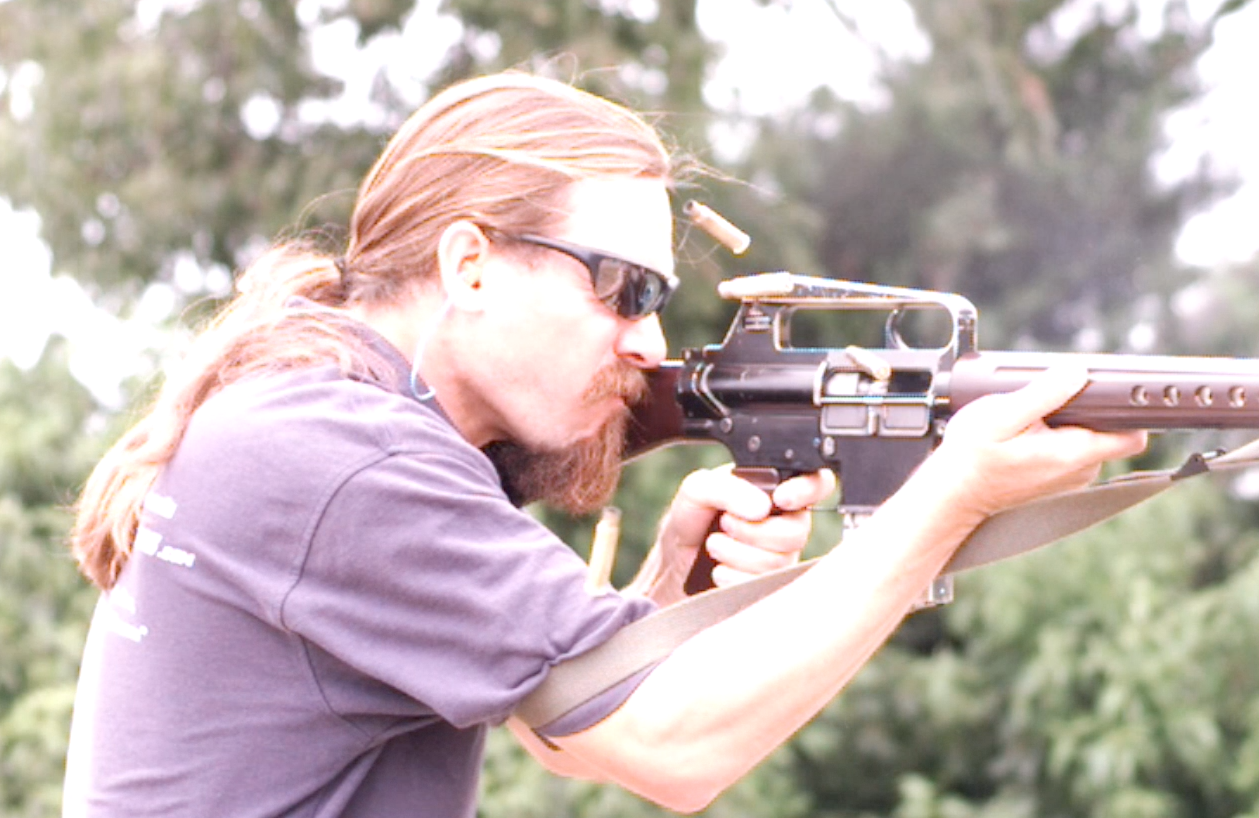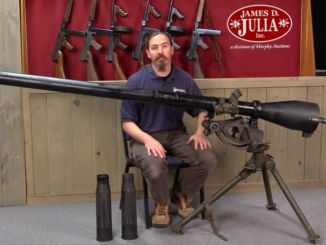The M1D was the final adopted form of John Garands sniper M1 rifle, originally the M1E8. It was intended to be a kit issued in the field to add optical sights to any rifle deemed worthy, and retained that capability in a slightly different form than originally intended. Garland’s initial plan was to design a sleeve that could fit over the barrel of a rifle, with a scope mounting bracket – the final production version instead used a new whole barrel with the scope mount integrally attached. However, this new barrel was still a part easily installed by a field armorer.
The scope was offset to the left of the receiver so as not to interfere with the Garand’s clip loading, and issued with a leather cheek pad to give the shooter’s cheek weld a matching offset to the left. The scope used with the M1D was the M84, a 2.2x optic with a simple vertical post reticle and hinger metal covers to protect the windage and elevation adjustment knobs. Accuracy of the M1D was not substantially different from regular M1 rifles, with its advantage coming from magnified optics rather than improved mechanical accuracy.
The M1D was adopted too late to see significant service in the Korean War, and would serve until replaced by the M14 and M40 rifles.




Well it’s kind of ironic that the offset scope was applied to the M1 just like that for the Japanese Type 97. How is it that everyone without willingness to verify his knowledge about the subject assumes that the former is perfect and the latter is crap? One side had perfect logistics and the other did not…
Right? Additionally, the Type 97 has a 2.5 power scope, which is often called “too low powered” for sniping.
And technically it was better suited to sentry duty, since the low-power scope also had a very generous field of view as opposed to high power scopes with very narrow fields of view. Low power scopes are better for quick target acquisition. If you’re keeping watch near some place of very sensitive nature, do you prioritize finding intruders if there are any and putting lead in their direction with decent accuracy or do you prioritize being able to shoot an intruder’s [unmentionables] or eyeballs out with great precision?
Nicely caught,
it will be interesting to see if that catch prompts any wriggling.
In the mid 60’s, I was a Small Arms Repairman in Germany. A friend in a different section found four M-84 sniper scopes in a warehouse. At least one of them had the hinge portion of the mount with the large locking knob on it. I really wanted to sneak one home but in the end decided not to do it. The reticle was a post with a cross hair just below the top of rhe post. I was somewhat intrigued by the flip up dust covers abd the sun shade. Thanks for the memories.
First requirement to be a sniper:
Right Handed/Right Eye Dominant.
I do not know for certain but have a suspicion that a majority of the M1D’s that are being sold today are gunsmith specials, they take any m1 barrel and turn down the breech end to fit the Scope base.
In my research, M1D barrels have been counterfeited and merit carefully examination. Nearly all M1D barrels were stamped with drawing number D7312555. M1D barrels manufactured through the fall of 1952 had the drawing number stamped on the top, underneath the rear hand guard. M1D barrels manufactured after the fall of 1952 had the drawing number stamped on the right side, adjacent to the date.
Any firearm configuration that becomes disproportionately valuable compared to another becomes an instant favorite for fakers. I like buying “plain Jane” rifles. Once the collectors figure out that so many of the rifles that they’re looking at are fake, the standard configuration ones will be the “rare” version. ^__^
Good point, Brian. Did you read my first post? It is apparently easy to fool people with very little knowledge about the era. I once thought that making a fake sniper rifle simply involved turning down the bolt handle of a World Wars Era bolt-action rifle (unless we’re talking about a Ross Mk III or a K31), faking a scope mount and mounting a reproduction or so-called “replacement scope,” and then selling it to some interested sucker for half a million bucks!
In any case, offset scopes to me are better for marksmen whom anticipate the need to switch from scope to iron sights quickly. This is true for riflemen doing over-watch near friendly artillery units. The last thing you want is for some enemy scout or shock-trooper to jump out of inconveniently located thick cover and spray the artillerymen, who likely carry only their side arms while doing their main job (delivering HE a long way downrange).
Did I mess up?
Hmm, I’d guess that any “scout” or “shock-trooper” that jumped out of cover anywhere near an artillery unit wouldn’t live very long. Might be smarter to just call in an air strike or direct your own artillery onto the ammo dump.
I often wonder how much sniper vs. sniper really goes on outside books and movies. ^__^
Not as much as you’d like but it does happen. Generally we prefer to avoid sniper duels and call in the artillery.
“Once the collectors figure out that so many of the rifles that they’re looking at are fake, the standard configuration ones will be the “rare” version. ^__^”
That reminds me of the beatles “butcher-baby” album cover. Because so many people tried to cash in on the rare original-issue version by doctoring later (covered-over) issues, the undoctored versions eventually became the rarest ones commanding the highest prices.
It would be interesting to know how they selected M1 rifles for conversion to M1D’s. If they did it on the basis of accuracy testing it would seem strange to then immediately swap out the barrel, the component most responsible for that accuracy in the first place.
CMP currently has a lot of real M1 D and -C rifles with reproduction scopes for sale.
They are also really proud of them. They were pricey when I dropped by the Alabama Store a few months ago.
This the version I got for my dad back in the 1990’s.
” have a suspicion that a majority of the M1D’s that are being sold today are gunsmith specials “
That’s why I was very glad to see Ian finally addressing the giant elephant in the room that unfortunately gets ignored or downplayed far too frequently: that a disturbingly high percentage of premium-priced collectible firearms are in fact bogus.
In addition, auction houses like Julia could certainly do more to try to curtail this distasteful practice. In the case of M1D rifles, since they were existing bog-standard Garands later re-fitted with a non-original barrel, it would seem obvious to call out the barrel markings (or better yet, photograph them) rather than just noting the barrel’s year of manufacture, as Julia did here on the site’s listing page.
It’s funny that DIY online auctions like Gunbroker often have a lot more relevant details, such as close-up photos of all the things that discerning collectors would want to pay particular attention to.
While the M1D sells for a sufficiently low price that getting stuck with a fake one is not a big loss, I’ve got to wonder about many of the antique guns selling for tens or even hundreds of thousands of dollars. It just seems far too easy for someone to take that old Winchester he inherited from his grandfather, put some fancy engravings on it, concoct a colorful story, and then see what kind of ridiculous price people are willing to pay. (I’m thankful that although auction sites like Julia’s are filled with these kind of high-priced (faith-based?) custom firearms, Forgotten Weapons is not.)
It’s said that a lot of the more recent “commemorative editions” have parts that were borderline for the rejects bin, and that they weren’t built to withstand much use, but rather in the knowledge that they would sit around in their boxes in the hope that their prices would rise.
I’d have a hard time believing such rumors alleging that commemorative editions intentionally use substandard parts, unless actual factory workers were saying this. It’s quite possible though, that some of the special treatments like nickel plating or whatever else could cause unique problems not present on the regular production runs, and the low volume and lack of testing at either the factory or the buyer’s end could allow such problems to persist undetected.
Anyway, the mobs who buy and hoard such overpriced ‘collectibles’ thinking they’ll be worth a fortune someday are playing a fool’s game. From Billy Beer to Beanie Babies and beyond,
When I got into garands some years ago I was ate up with getting a sniper model. (I picked up a service model m1 from cmp for 650) That h&r was only a 3 minute shooter at 100 yards. Then after looking at the price of a m1d or c and realizing they are not minute of angle shooters I lost interest fast…